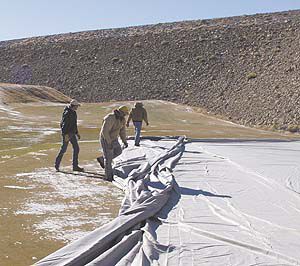| Millsite Dam is seen in the background on hole number three at the Millsite Golf Course. This picture shows the green covers being rolled out last fall. The green covers will come off on March 10 and the golf course will open for the season on March 15. Questions on the Millsite dam could affect the golf course. |
What do you do with a reservoir that is filling up with silt and the storage capacity is being reduced by 74 acre feet of water per year? And, what do you do with that same dam that does not meet safety criteria? The answers are you can raise the dam to increase the storage capacity, you can decommission the dam, you can build a bigger spillway to meet safety regulations, or you can dredge the silt out of the reservoir.
Tracy Behling, manager of the Ferron Canal Company, opened the scoping meeting for the Millsite Dam to investigate some solutions to the problems at the reservoir. We know we have a sediment problem at Millsite and we are losing water storage. We asked the National Resources Conservation Services dam safety division for help and they are here tonight to explain our options, said Behling. Millsite was built in 1969-70 under the NRCS watershed program. Now, it does not meet the safety regulations for dams, and with our sediment problem, we asked if they could help us with solutions.
Norm Evenstad of the NRCS stated, Millsite is a high hazard structure and is the first of the dams built during that period to go through the rehab process. We are in the planning phase now and are looking for alternatives and estimated costs. The NRCS will cover 65 percent of the cost of the plan that is decided upon, and the remaining 35 percent is the responsibility of the canal company and others that are involved with Millsite.
When this process is complete, and the rehabilitation is done to the dam if that is the choice made, the life of the dam will be extended for at least 50 more years. We are hoping for a solution that will extend it for another 100 years.
The problem with the safety at Millsite is the auxiliary spillway. It was designed to provide 12,000 cubic feet per second of water release. The minimum requirement now is 30,000-40,000 CFS, said Evenstad. At the very least, more spillway is required, stated Evenstad.
Evenstad explained the process NRCS has been through to arrive at the options now being explored. He said there has been numerous studies done on site at the dam and divers have gone in and photographed the dam under the water line. Those divers found no major problems and the decision was made that Millsite is a candidate for rehabilitation.
The alternatives which have been deemed as valid are the no action alternative, the decommission alternative, and four rehab alternatives. In the no action alternative, the operation of Millsite Dam would remain the same with nothing being done to address the safety and sediment issues. Eventually the dam would be required to be decommissioned due to safety and liability concerns.
For the decommission alternative, requirements would be to remove the dam and restore the entire area to its original condition. This alternative would require the City of Ferron, the Ferron Canal Company and PacifiCorp to develop a new water source or purchase water from an existing source to replace the loss supplied by the current reservoir. The cost for decommissioning a dam is usually prohibitive.
There are four rehab alternatives and the first is to raise the existing spillway one foot to allow for another 50 years of sediment storage, and to construct an additional roller compacted concrete auxiliary spillway (685 feet). The estimated cost for this alternative is $9,324,000.
Rehab alternative number two is to raise the existing auxiliary spillway and the crest of the dam 2.5 feet to provide another 100 years of sediment storage, and construct an additional roller compacted concrete auxiliary spillway (1,320 feet). The projected cost for this alternative is $15,802,000.
Alternative number three consists of raising the existing auxiliary spillway and crest of the dam 2.5 feet and constructing an additional roller compacted concrete auxiliary spillway (500 feet). The estimated cost for this alternative is $7,827,000.
The number four alternative is to raise the existing auxiliary spillway and the crest of the dam seven feet and construct an additional roller compacted concrete auxiliary spillway (600 feet) with an estimated cost of $9,945,000. The differences between each of these alternatives is the size of the additional auxiliary spillway due to a different location along the existing dam.
As a side note, the projected cost for dredging the sediment from the reservoir to increase the storage capacity to what it was originally is $51,126,000.
Residents may send written or electronic comments to: Norm Evenstad, Water Resources Coordinator, USDA-NRCS, Wallace F. Bennett Federal Building, 125 South State Street, Room 4418, Salt Lake City, UT 84138-1100. Telephone is 1-801-524-4569, fax is 1-801-524-4593, and email is norm.evenstad@ut.usda.gov.

